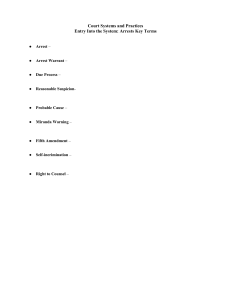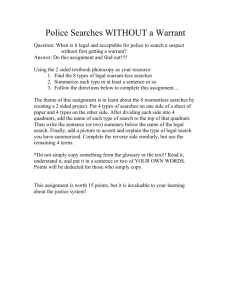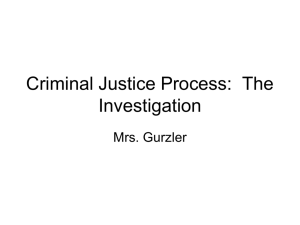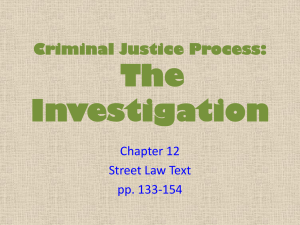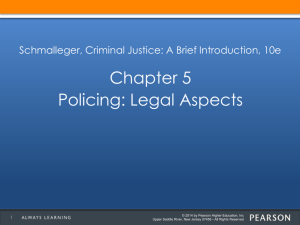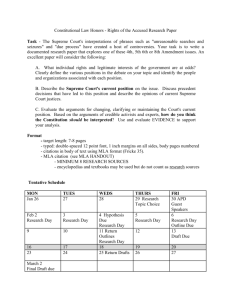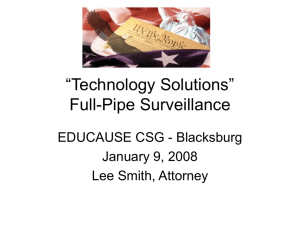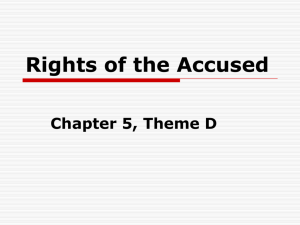Law Chapter 12 - Somerset Academy
advertisement
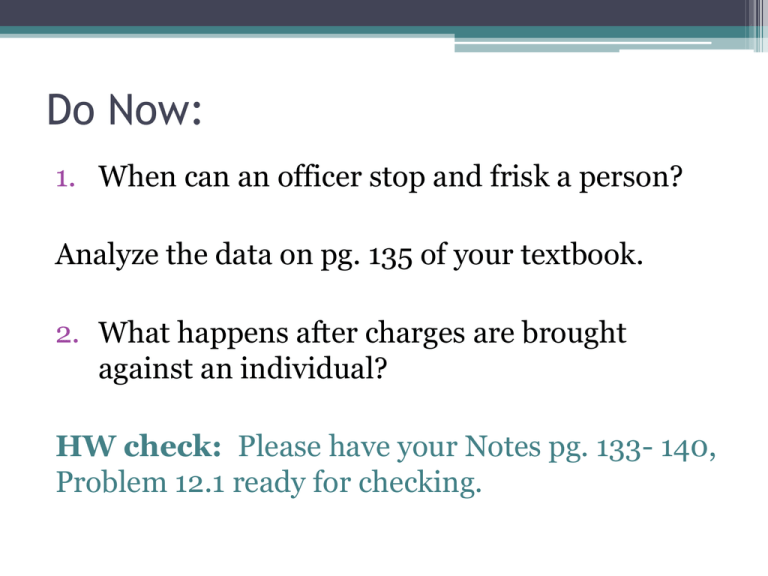
Do Now: 1. When can an officer stop and frisk a person? Analyze the data on pg. 135 of your textbook. 2. What happens after charges are brought against an individual? HW check: Please have your Notes pg. 133- 140, Problem 12.1 ready for checking. Criminal Justice Process: The Investigation Key Terms Arrest Arrest warrant Probable cause Drug courier profile Corroborate Reasonable suspicion Stop and frisk Exclusionary rule Search warrant Bona fide Affidavit Consent Contraband Racial profiling Interrogate Self-incrimination Miranda warning The Criminal Justice Process • Includes everything that happens to a person ▫ From arrest through prosecution ▫ Conviction to release from the state • Majority of crimes are investigated and are adjudicated (judged) ARREST • Seizure under the Fourth Amendment – protects citizens against “unreasonable searches & seizures” ▫ Reasonable • 2 ways a policy officer can arrest 1. Warrant – court order issued by a judge 2. Probable Cause – reasonable belief, with some facts; not just suspicion or hunch • Drug courier profile ▫ Provides a basis stop and question or establish probably cause Arrest • Reasonable suspicion ▫ Stop and frisk - may pat-down person’s outer clothing • U.S. Supreme Court 1997 ▫ Police can order passengers out of car when making a lawful traffic stop Steps to Take if Arrested 1. 2. 3. 4. 5. 6. 7. Do not struggle with police Give your name, address, ph. # Keep quiet until you have spoken to lawyer Do not discuss case with anyone Do not sign any statements Ask for written receipt if personal items taken Call a trusted friend or family – tell where your are, bail or bond 8. Upon release – unsecured bond or post cash bond 9. Find out court due date, do not be late or miss 10. Only discuss case with your lawyer Assignment / Classwork: • Groups of 2: ▫ Problem 12.2 and 12.3 Homework due 11/19: • Continue Notes pg. 140-154 • Substitute will check your notes • Will provide you with classwork – to be collected at end of class SEARCH AND SEIZURES • Fourth Amendment ▫ Right to be free from “unreasonable searches and seizures” ▫ Established conditions on the use of search warrants ▫ Does not give citizens absolute right to privacy ▫ Does not prohibit all searches –only unreasonable ▫ Exceptions to the basic rules: Exclusionary rule – evidence found in search cannot be used in trial in an unreasonable search Searches With a Warrant • Search Warrant – court order obtained from a judge. ▫ Bona fide – need to search ▫ Affidavit must be filed – a sworn statement ▫ Must describe the person or place and particulars to be seized ▫ Limited time – days, some states….daytime ▫ Police must ‘knock and announce’ ▫ U.S. Supreme Court – has allowed ‘no-knock’ Search Without a Warrant • Must be reasonable ▫ Search incident to a lawful arrest Grab area search Protect sweep ▫ Stop and Frisk Search is for weapons only Plain feel exception ▫ Consent ▫ Plain view – can seize the contraband ▫ Hot pursuit ▫ Vehicle searches –with probable cause ▫ Emergency situations ▫ Border and air searches Public School Searches • U.S. Supreme Court granted school authorities broad discretion • Reasonable suspicion • Student lockers • Drug-sniffing dogs • Strip searches are not allowed and are considered unreasonable Suspicionless Searches • Special circumstances to meet special needs beyond the goals of routine law enforcement ▫ Fixed-point searches at or near borders to detect illegal aliens ▫ Mandatory drug and alcohol test for railroad employees Racial Profiling in Police Investigations • Inappropriate • May use race as one factor among others INTERROGATION AND CONFESSIONS • After arrest, police question • Fifth Amendment ▫ Provides citizens privilege again self-incrimination ▫ “Plead the Fifth” • Sixth Amendment ▫ Right to an attorney • Miranda rights before questioning ▫ Police may question - related to public safety before reading the Miranda ▫ Failure to give Miranda warnings does not affect the validity of an arrest End of Chapter 12 Study for quiz next class 10 questions from Chp 12 5 questions from Chp 11
